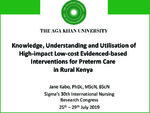| dc.contributor.author | Kabo, Jane | |
| dc.date.accessioned | 2021-03-11T12:27:30Z | |
| dc.date.available | 2021-03-11T12:27:30Z | |
| dc.date.issued | 2019-07-25 | |
| dc.identifier.uri | http://erepository.kibu.ac.ke/handle/123456789/2311 | |
| dc.description.abstract | Approximately 25% of 4 million neonatal deaths globally are due to prematurity (WHO 2015; Gondwe et al 2017). A majority of the preterm babies deaths occurs within the the first week of life (Penfold et al 2013). 60% of the preterm births occur in sub-Saharan Africa (Baker et al 2017). Preterm birth rate in Kenya is 12.3% with some rural counties having higher rates (KDHS, 2014). International consensus exists on effectiveness of high-impact low-cost evidence-based interventions to improve preterm outcomes (WHO 2016).
•
Kenya has adopted and contextualised the following preterm care guidelines:
–
Immediate and exclusive breastfeeding
–
Thermal protection of the new-born: a practical guide
–
Kangaroo Mother Care: Clinical Implementation Guidelines
–
Basic paediatric protocols (Resuscitation)
–
Use of chlorhexidine for new-born umbilical cord care
•
Despite development of these guidelines, there is paucity of literature on availability and effective implementation by health professionals | en_US |
| dc.language.iso | en | en_US |
| dc.publisher | KIBU | en_US |
| dc.rights | Attribution-NonCommercial-ShareAlike 3.0 United States | * |
| dc.rights.uri | http://creativecommons.org/licenses/by-nc-sa/3.0/us/ | * |
| dc.subject | High-impact interventions | en_US |
| dc.subject | Low-cost interventions | en_US |
| dc.subject | Evidence-based interventions | en_US |
| dc.title | Knowledge, Understanding and Utilisation of High-impact Low-cost Evidenced-based Interventions for Preterm Carein Rural Kenya | en_US |
| dc.type | Other | en_US |

